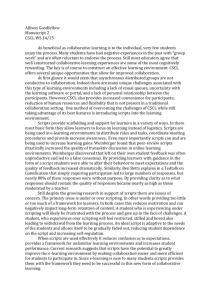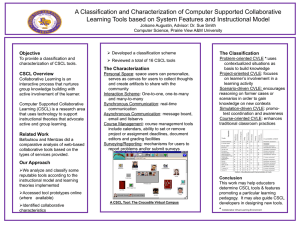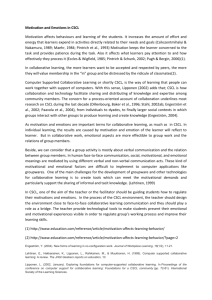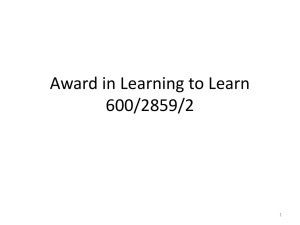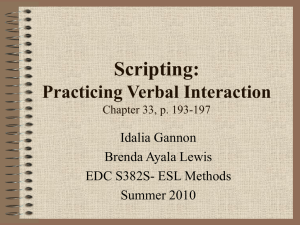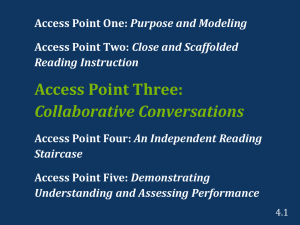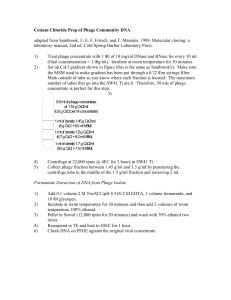scripting CSCL
advertisement
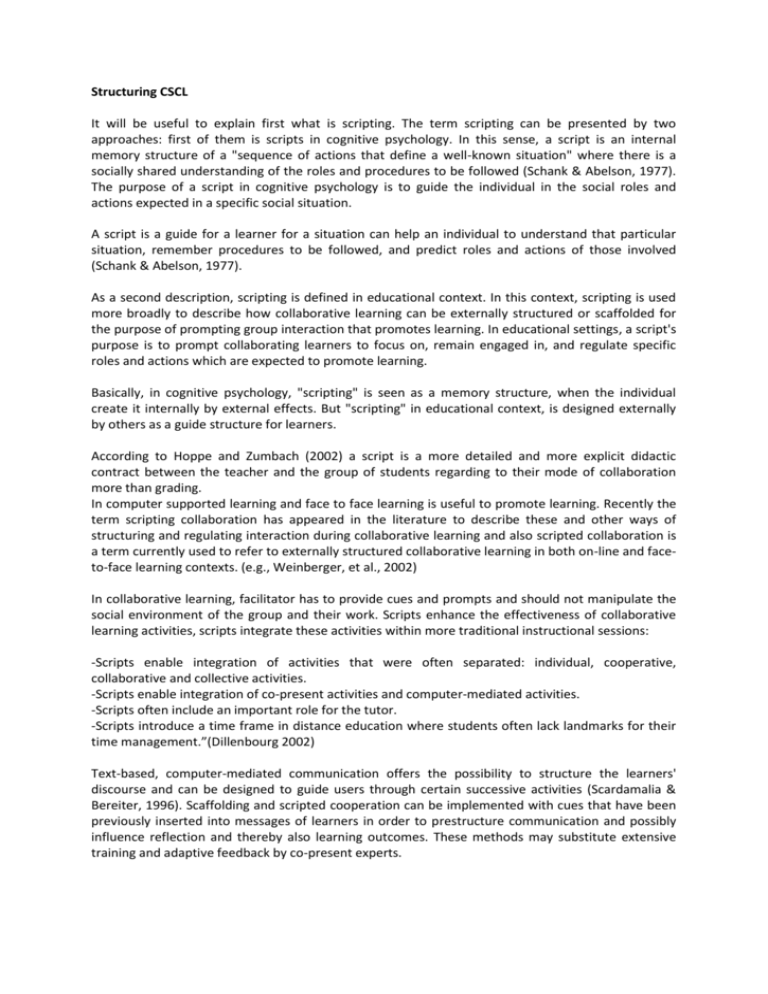
Structuring CSCL It will be useful to explain first what is scripting. The term scripting can be presented by two approaches: first of them is scripts in cognitive psychology. In this sense, a script is an internal memory structure of a "sequence of actions that define a well-known situation" where there is a socially shared understanding of the roles and procedures to be followed (Schank & Abelson, 1977). The purpose of a script in cognitive psychology is to guide the individual in the social roles and actions expected in a specific social situation. A script is a guide for a learner for a situation can help an individual to understand that particular situation, remember procedures to be followed, and predict roles and actions of those involved (Schank & Abelson, 1977). As a second description, scripting is defined in educational context. In this context, scripting is used more broadly to describe how collaborative learning can be externally structured or scaffolded for the purpose of prompting group interaction that promotes learning. In educational settings, a script's purpose is to prompt collaborating learners to focus on, remain engaged in, and regulate specific roles and actions which are expected to promote learning. Basically, in cognitive psychology, "scripting" is seen as a memory structure, when the individual create it internally by external effects. But "scripting" in educational context, is designed externally by others as a guide structure for learners. According to Hoppe and Zumbach (2002) a script is a more detailed and more explicit didactic contract between the teacher and the group of students regarding to their mode of collaboration more than grading. In computer supported learning and face to face learning is useful to promote learning. Recently the term scripting collaboration has appeared in the literature to describe these and other ways of structuring and regulating interaction during collaborative learning and also scripted collaboration is a term currently used to refer to externally structured collaborative learning in both on-line and faceto-face learning contexts. (e.g., Weinberger, et al., 2002) In collaborative learning, facilitator has to provide cues and prompts and should not manipulate the social environment of the group and their work. Scripts enhance the effectiveness of collaborative learning activities, scripts integrate these activities within more traditional instructional sessions: -Scripts enable integration of activities that were often separated: individual, cooperative, collaborative and collective activities. -Scripts enable integration of co-present activities and computer-mediated activities. -Scripts often include an important role for the tutor. -Scripts introduce a time frame in distance education where students often lack landmarks for their time management.”(Dillenbourg 2002) Text-based, computer-mediated communication offers the possibility to structure the learners' discourse and can be designed to guide users through certain successive activities (Scardamalia & Bereiter, 1996). Scaffolding and scripted cooperation can be implemented with cues that have been previously inserted into messages of learners in order to prestructure communication and possibly influence reflection and thereby also learning outcomes. These methods may substitute extensive training and adaptive feedback by co-present experts. Dillenbourg, P. (2002). Over-scripting CSCL: The risks of blending collaborative learning with instructional design. Three worlds of CSCL. Can we support CSCL?, 61-91. Scardamalia, M., & Bereiter, C. (2006). Knowledge building: Theory, pedagogy, and technology. na. Schank, R. C, & Abelson, R. P. (1977). Scripts, plans, goals and understandings. Hillsdale, NJ: Erlbaum. Weinberger, A., Fischer, F., & Mandl, H. (2002). Fostering computer-supported collaboration with cooperation scripts and scaffolds. In G. Stahl (Ed.), Computer support for collaborative learning: Foundations of a CSCL community (pp. 573-574). Mahwah, NJ: Erlbaum. Zumbach, J., Muehlenbrock, M., Jansen, M., Reimann, P., & Hoppe, H. U. (2002, January). Multidimensional tracking in virtual learning teams: An exploratory study. In Proceedings of the Conference on Computer Support for Collaborative Learning: Foundations for a CSCL Community (pp. 650-651). International Society of the Learning Sciences.
